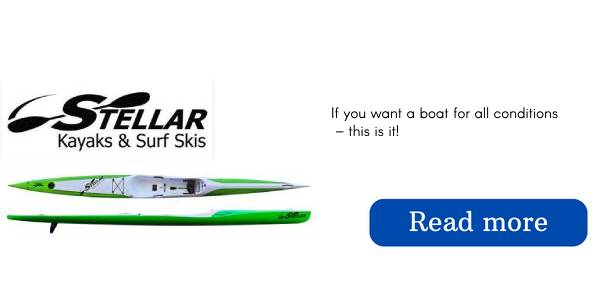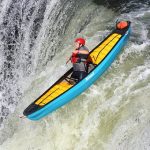Finally decided to buy a kayak but there are so many choices. What kayak do you want?
Inflatable, hardshell, solo, tandem, recreational, fishing, touring, etc. are all types of kayaks.
Traditionally hardshell kayaks have been the number one choice. Inflatable kayaks have improved a lot over the years and are a great option.
This guide is designed to help you choose between an inflatable kayak and a hardshell kayak. Which is best for you.
The Great Debate Inflatable Kayak vs Hardshell Kayak
There is such a wide range of kayaks to pick from nowadays. Which one is best for you? Inflatable kayaks are convenient because they can be easily transported and they have drop stitch floors and keels that provide great performance.
Hardshell kayaks are still the best option for people who want to use them for recreational purposes or for more advanced kayaking.
Lets look at the advantages and disadvantages of inflatable and hardshell kayaks.
What is an Inflatable Kayak?
An inflatable kayak is exactly what it sounds like. A kayak is a soft plastic or rubber structure that is inflated into a kayak. Most boats have three air chambers in their hulls. 2 sides and a bottom.
This type of kayak has evolved over a few years with technological advances and is now the most admired modern boat. People used to think that yaks were not good animals and were unsafe, but now everyone wants to own one.
Many companies that specialize in inflatable boats have invested money and time into making them high quality and durable. The yaks are being challenged by these animals in terms of both their abilities and the demand for them.
These kind of yaks are inflated and deflated before and after use, as the name suggests. Their portability, pocket-friendliness, ease of transport, and durability are some of the reasons they are so popular. Here are the pros and cons of inflatable boats.
Pros Of Inflatable Kayaks
Portability
Many people love inflatable boats because they are easy to transport. Most boats in this category weigh between thirty and forty pounds, while other inflatable yaks weigh less than thirty. The best way to transport an inflatable kayak is to deflate it and store it in a backpack or the trunk of a car.
Solo kayakers prefer inflatable boats because they are easy to carry and don’t require a lot of storage space. A yak is not as difficult to carry as a rigid one.
Performance
If you’re looking for a stable ride while paddling, an inflatable boat is a great option. Yaks of this type are especially good for novice kayakers whose primary concern is staying upright while paddling.
This boat is also ideal for you if you enjoy recreational paddling. The performance of an inflatable kayak depends on the company that made it and the materials used.
Safety
You will be safe if you use your inflatable kayak on the waters that the manufacturer has intended for it. Inflatable animals are less likely to cause huge injury impact than rigid animals like yaks, which can easily give you marks when one gets knocked on the head.
You should prioritize safety when making a purchase, so check to see if the following safety measures have been put in place.
Cons Of Inflatable Kayaks
Control
If you’re not an experienced kayaker who has been using inflatable yaks for years, controlling them can be challenging. Its light nature makes it hard to control, especially if you are trying to keep it in one spot in still water.
This type of kayak is not good for calm water, but it is good for rough or flowing water. Nowadays, there are advanced inflatable yaks made with sturdy and durable materials that can withstand all sorts of kayaking excursions and class II and IV water.
Inflating And Deflating
Although it can be restrictive, especially when you’re short on time, having to inflate and deflate your own yak can be worthwhile. It takes about ten minutes to raise your boats using a pump. If you don’t have a pump, it will take even longer.
In addition, there are other issues, such as maintaining the correct air pressure level for maximum kayak performance. If there is too much air pressure in your kayak, it will be difficult to move it around because it will be very stiff.
It is important to regularly wash your boat in order to remove dirt and any potential smells.
You Get What You Pay For
Inflatable boats are pocket-friendly compared to rigid ones. However, the price of these yaks varies depending on the materials used and the animal’s capabilities. If you’re looking for a cheap model, be aware that it probably won’t be very durable and won’t last for more than two summers.
One has to spend more money to get a durable and lasting kayak. You need to decide how much you are willing to spend on something that will last longer.
Inflatable Kayak Materials And Construction
Vinyl
Vinyl can be used for kayaks. Vinyl is one of the feed components of PVC. Vinyl is not as tough as PVC, but it is more elastic. It is only used in very inexpensive kayaks.
Vinyl kayaks are still a very good value. They will not last as long as kayaks made from PVC or Hypalon.
PVC
PVC is a lightweight plastic material that is commonly used in many marine inflatables. It is durable and has a long lifespan. PVC is a good choice of material to use for constructing an inflatable SUP because it can be easily heat-sealed into the desired hull shape and the core.
PVC is usually stronger and more abrasion-resistant when it is in the form of a laminate rather than a single layer.
Hypalon
Hypalon is another material choice. Hypalon costs more to produce than PVC because it requires glue instead of heat welding. Hypalon is better than PVC at resisting UV damage and abrading.
Hypalon is the material most commonly used to make military or coastguard inflatable boats.
Drop-Stitch Construction
In drop-stitch construction, two layers of PVC fabric are joined together with a large number of connecting threads. The fabric is kept a certain distance apart by the threads when the structure is inflated. Inflatable fabric can be used to create very rigid structures.
This process involves inflating airplane wings for the military. This construction method is used for most inflatable stand up paddleboards and kayaks.
The outer material layers must be PVC as it is not possible to construct it from Hypalon.
What is a Hardshell Kayak?
A hardshell kayak is a kayak made out of hard materials like hard plastic, fiberglass, or wood. It has a rigid structure.
Yaks can be made out of different materials, such as wood, fiberglass, plastic, and sometimes composite materials like Kevlar. Hard-shell kayaks are generally considered heavyweight because they weigh at least 55 pounds, thanks to the hard materials used.
The cost of these kayaks is more than that of any other quality inflatable kayak. Just as fate would have it, these kayaks have their share of advantages and disadvantages, just like inflatable ones.
We will weigh the pros and cons of rigid yaks below to help you make a decision.
Pros Of Rigid Kayaks
Durable
The most significant thing about rigid yaks is their durability. It doesn’t matter what model you are interested in. The longevity of each material used varies, but all materials used for rigid yaks are long lasting.
Although they are more expensive than inflatable ones, they will last much longer. If you’re not worried about storing or transporting your equipment, this is a good option to buy so you don’t have to keep going back to the sports store.
Easy Setup
Instead of inflating this yak, you only need to fill it with water. Once you have arrived at your destination, you are all set. After you load your boat onto the trailer, you can head to the water.
Once you’re done, you just reverse the process to head back home.
Performance
Although yak are not very flexible, they are easy to control while kayaking, even in rough water. When you’re sailing on calm waters, you can move quickly since you have control over your boat.
You can also turn around quickly to head in a specific direction without any difficulties. A kayak like this will provide a good time while you are using it.
Cons Of Rigid Kayaks
Maintenance
Maintaining a hard-shell boat in good condition can be a bit of a hustle, plus the cost required.
Although it may be expensive to buy a yak, they require little maintenance. There is no rubber padding on the outside of the car, so it is vulnerable to things like rocks and other objects hitting it, which can leave scratches.
The materials used in the construction of yaks matter, and as you know, yaks are typically made of plastic, fiberglass, and wood. A plastic boat is a good choice because it is not easily damaged.
However, if it does get damaged, you will need to spend more money than you would for a boat made from another material.
Uncomfortable
Contrary to their counterpart, hard-shell kayaks are not more comfortable and supportive due to their soft surface. Hard-shell kayaks have a hard surface, which can be uncomfortable for kayakers, especially those with back issues.
If you spend a lot of time on the water and have back problems, this yak is not for you. There are other options available. This text is saying that people who have had bad experiences with yaks are less likely to continue doing the activity.
Storage And Transportation
Hardshell kayaks are harder to transport because of their size. Stories abound of people who have lost their kayaks after leaving them beside the road because they were not secured properly.
It’s important to tie your kayak to your car or truck before driving on the highway.
Hardshell Kayak Materials And Construction
Lexan Polycarbonate
Lexan Polycarbonate can be used to create kayaks with hardshells and transparent hulls. Polycarbonate is a high strength plastic material that is commonly found in safety glasses and ballistic panels.
It is also used in food packaging, Compact Discs, and medical devices.
Fiberglass or Carbon Fiber
The most expensive hardshell rigid construction is molded fiberglass or carbon fiber. These materials are often used in the aerospace industry because of their strength and durability.
A kayak made out of this material will be both light and rigid, but it will also be the most costly option. Fiberglass can be repaired using resin and glass cloth.
Wood
Kayaks made of wood are the most expensive. If you have woodworking skills or are willing to learn them, you can make your own kayak out of wood. Wood kayaks can be lightweight and stiff, and damage can be easily repaired by replacing or refinishing the affected wood.
There is something special about wood construction that molded plastic or fiberglass kayaks cannot match. Wood kayaks require a lot of care. They should be stored in a dry place out of direct sunlight.
Thermoformed
A more expensive molding process called thermoforming can be used. The plastic material is formed into sheets, which are then put onto a model. With thermoforming, several layers of sheets can be used to create different strength and appearance characteristics.
Roto-molded kayaks are the heaviest type of kayak, followed by fiberglass kayaks, which are lighter. Thermoformed kayaks are just as tough as roto-molded or fiberglass kayaks.
They can be repaired fairly easily.
HDPE – Roto-molded
HDPE or roto-molded polyethylene. In this process, a plastic powder is put into a mold, which is then heated and spun until the powder melts and takes the shape of the kayak. It is then cooled and it’s finished. Roto-molded kayaks are heavy.
They are durable and can take some punches against rocks and other objects. It is difficult to repair a crack in the hull or replace a whole piece of polyethylene because few adhesives stick to it.
Final Short
choosing between two things that are both good can be difficult We have listed all of the features, pros, and cons of both kayaks for you to see. You will need to consider your personal preferences to make a final decision.
If you are just starting out and want to improve your paddling skills, we recommend getting an inflatable kayak. They are a good option if you are on a tight budget. In addition to being easy to transport, store, and ride, bicycles are also cost-friendly and require little effort to use.
Make sure to choose the right inflatable or rigid yak for your needs from the many options available. We hope you find the right kayak for you.




